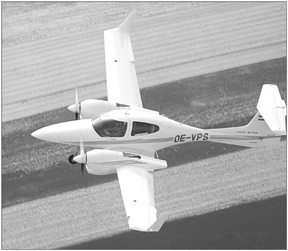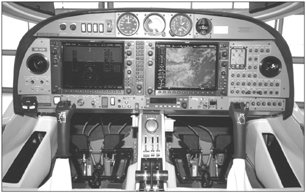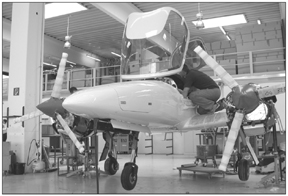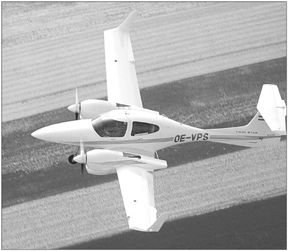
by Paul Bertorelli
In the realm of light-aircraft GA, engine development moves at a glacial pace if it moves at all. Its not that Lycoming and Continental havent considered innovative engine ideas, its just that neither has followed through with anything exciting.
Thus, when Diamond Aircraft proposed to build a new 200-knot twin powered by a pair of diesel engines, buyers took notice in the way horseplayers occasionally bet a 30-to-1 shot. It would at least be interesting to watch.
Yet a scant three years later, Diamond is shipping diesel-powered Twin Stars at the rate of three a week and demand and interest appear to be strong. The Thielert Aircraft Engine diesels that power both single and twin-engine versions of the Diamond Star represent one of the most innovative and rapidly developed engine initiatives weve seen.
The diesel twin isn’t available for the U.S. market yet but probably will be within two years. A Lycoming version powered by a pair of 180-HP IO-360s is expected to be certified and available for the U.S. market later this year or early next. The Lycoming version was expected to appear at Oshkosh in July.
We recently traveled to Diamonds Wiener Neustadt factory in Austria to fly both versions of the Twin Star. The diesel we flew was a production model, the Lycoming version a test airplane. Although final U.S. prices havent been established, Diamonds North American CEO, Peter Maurer, told us an IFR-capable, Garmin 1000-equipped Twin Star will sell for about $452,000 with either engine type, plus about $40,000 for a known-ice TKS system.
Airframe
On our tour of the Wiener Neustadt plant, we saw dozens of twins in various stages of completion. This leads us to conclude that Diamond has succeeded in bringing the Twin Star quickly to market by making its design basis nearly identical to the established single-engine DA40 Star.
The twins fuselage and wing section outboard of the engines are virtually identical to the single, although the twins structure is carbon fiber rather than glass, to save weight and add strength for the higher loads, and the wings have winglets to help with single-engine performance. The twin has an extended nose for baggage and to carry the nosegear assembly. Diamond principal Christian Dries specified that the nose baggage area be sized to accommodate two golf bags and it appears to be just that size, with a 66-pound limit. The rear baggage compartment behind the seats accommodates an additional 100 pounds.
The Twin Stars control circuitry and systems are similar to the single but there are two exceptions worth noting. The obvious one is retractable landing gear, an electro-hydraulic design similar to the Piper system with back-up extension via gravity drop when hydraulic pressure against the uplocks is released. Second, the Twin Star has an electrically activated pitch limiter that restricts up elevator to 2.5 degrees less than full deflection with landing flaps and power above 20 percent.
As in the single, fuel is carried in three aluminum cells in each wing, with a total capacity of 52 gallons with a gallon unusable in each side. A long-range option will provide 74 gallons for the diesel, with the same tankage being standard for the gasoline model. The gasoline long-range tanks will hold 95 gallons.
The panel is equipped with Garmins G1000 with a dedicated engine monitoring page to keep track of the diesels, including critical temps, percent power and fuel flow. This system is one of the best designed engine displays weve seen.
The engines are the latest iteration of the Thielert TAE 1.7 Centurion diesels and burn Jet-A, although the DA40 singles are certified to burn either Jet-A or European auto diesel. Currently, the engines have a 1000-hour TBR (time between replacement) but thats expected to be extended to 1600 hours by this fall and, eventually, to 2400 hours.
In a strategy clearly designed to convince buyers of its long-term commitment to the market, Thielert is subsidizing engine replacement on a 2400-hour TBR basis, thus early owners wont have to bear the burden of a foreshortened engine replacement cycle. If Thielerts engine life extension program stays on track, the higher TBRs will be in place before the engines require replacement. This is a customer-friendly but somewhat risky program for Thielert if problems surface in the engines prior to 2400 hours.
Straight to the chase here; basically, the diesel Twin Star is a 165- to 168-knot airplane burning about 12 to 13 gallons total. As youd expect, with 180 horsepower per side, the Lycoming version climbs and cruises faster on more gas. At 10,000 feet, the Lycoming Twin Star trued at 172 knots on 22.5 GPH, but Michael Feinig, Diamonds Austrian CEO, told us he has seen higher speeds.
The airplane we flew was a test article so in fairness, we cant hold Diamond to any hard numbers. we’ll simply offer some impressions.
As for the diesel, Diamond openly admits to disappointment in falling short of its original claims of 200 knots for the Twin Star. Those claims were based on proof-of-concept test flying with early variants of the TAE engines. After those test numbers were published, Thielert made changes in the engines that reduced the airplanes performance in favor of whats hoped will be improved engine longevity.
Although Diamond isn’t happy with the stunted performance, the reality is that airplane will live or die on the service reliability of the engines so we give Diamond and Thielert a pass for taking a conservative approach.Better that than an engine with a troubled service life which could hinder the projects success or even kill it outright. But there’s no denying that the twin doesnt live up to its original billing.
If its any consolation, the Twin Star seems to exceed the performance claims given in the POH, which struck us as surprisingly modest. For example, for the conditions in which we flew, the POH promised 162 knots at 11,000 feet but we recorded 168 knots TAS on a total fuel flow of 13 GPH at about 90 percent power. Inching the power back to 70 percent yielded 148 knots on 10 GPH. According to the G1000s range map, that put most of Europe in reach from Vienna, extending nearly to Moscow to the east, London to the west and Algiers and much of North Africa to the south. Thats with standard tanks providing 50 gallons of Jet-A. With 74 gallons available, still air range in economy cruise extends to just over 1000 miles, with a 45-minute reserve.
While decent range on minimal fuel is the Twin Stars forte, climb rate isn’t. With only 135 HP per side at moderate weight, we found the climb rate to be adequate but hardly impressive for a twin. Initial climb off the runway on a warm Austrian summer day (about 80 degrees) was 1000 FPM burning 7.5 GPH per side. By 8500 feet, climb rate had declined to 750 FPM and will be less at gross weight. (With full fuel, we were 462 pounds below gross weight.)
By comparison, the Lycoming version practically leapt off the runway with an initial climb rate of 1500 FPM and it easily sustained 1000 FPM to 10,000 feet. To do that, however, it burns twice the fuel as the diesel model does. Throughout our numerous climbs and maneuvering, the diesel engine temperatures stayed we’ll within the green arcs, as displayed on the G1000s engine parameter page, a result of the Centurions dual cooling strategy with both oil and water cooling.

Handling, Engine Out
The Twin Star handles like what it is: a DA40 with two engines instead of one. Unlike the single, the twin has a steerable nosewheel, but with the added benefit of differential power, the Twin Star easily negotiates tight ground turns on the ramp. The throttles are entirely fly-by-wire and response on the ground requires a fine touch to avoid overthrusting. Visibility during taxi is excellent because the airplane sits higher than the DA40 single.
In flight, the roll rate and control feel are noticeably affected by having an engine hung on each wing. Its not ponderous but certainly not as sprightly as the single-engine Star- no surprise there. We found the console-mounted pitch trim wheel to be we’ll positioned and with gearing aggressive enough not to require undue fussing. You can actually trim it with judicious movement of the right forearm. A rudder trim knob is mounted at the top of the center console and works through an anti-servo tab, as does the pitch trim.
Engine out procedures in the Twin Star are dumb-as-a-rock simple. There’s nothing to do, other than step on the ball, pitch up to Vyse (82 knots) and bank into the good engine. Feathering is automatic and to secure the engine, you turn off the engine master switch and the fuel.
Bringing a dead engine back is just as easy. Turn on the master switch and the engine automatically unfeathers the prop and starts itself. When its running, set the desired power and go. According to the POH, air starts have to be done at 6000 feet or lower but we did several restarts between 8000 and 11,000 feet, with engines still warm.
With both props turning clockwise, the Twin Star has a critical engine on the left side but because it lacks the surplus thrust of bigger twins, youd have to provoke it into a VMC roll. As twins go, it is gentle in both stalls and Vmc demos.
While pilots should have no trouble mastering the engine-out drill in a Twin Star, the same cant be said for eking out climb on a single engine.Bluntly, the diesel version has no thrust to spare and for single-engine work, it wont go uphill with anything but clean trim and precise pitch and speed. Its adequate but just, in our view.
Its relatively slow Vyse and Vmc speeds require a higher pitch angle than most twin drivers will be accustomed to, but you have to get it there or it wont climb or even maintain altitude. Although Feinig milked a couple of hundred feet of climb during single-engine ops-about what the book says it should do-it took us a few minutes of tweaking the rudder trim and hunting for the right pitch to get the airplane pointed up. A little mind over matter is necessary to accept a higher pitch angle than most twins want on a single engine.
Even then, single-engine climb was hardly awe-inspiring, in our estimation. Obviously, this wont improve with weight, so in flying this twin-or any twin, for that matter-keeping it as light as possible is a commonsense survival rule. In after takeoff engine-out situations, the Lycoming version will have a clear advantage because it has 360 total horseppower, versus the diesels 270. Thats not a trivial difference. The Lycoming version, easily delivered 300 to 400 FPM with one engine caged and it was easier to find the right speeds and pitch angle. But the downside is that single-engine work in the Lycoming version is the usual Chinese fire-drill of dead-foot/throttle/prop/mixture. In our view, the same task in the diesel version is quicker, easier and just better.
Engine Management
There are three immediate undisputables about the Thielert engines: They are the most sophisticated production piston aircraft engines flying, they do the job on only 103 cubic inches of total displacement and they are true single-lever FADEC-driven powerplants. Lets have no hand wringing over turbocharger controls, prop governors or mixture controls to be added later once the market has declared itself. The Thielerts do it all now, right out of the box and we think they do it well.
Start-up is diesel car-like. When the engine master switches are flipped on, a glow plug annunciator appears on the G1000 engine page. When they go out after five or six seconds, depending on ambient temperature, crank the engine and go. For hot starts, the glow plugs may not be necessary and you simply crank the starters.
Run-up is similarly automated. There are two buttons to the left of the PFD and a pair of switches to manually control the selection of engine FADEC channels. The run-up requires pushing and holding the buttons while the FADECs run their checks, including running the engines on both the A and B channels. There’s a brief increase in idle speed and a noticeable hiccup when the channels flip. When the idle returns to normal, the run-up is done. You can do these checks in the air, but only when the engine is idling. You can also manually select the A or B FADEC, if the spirit moves, although there should be no reason to do so barring a failure.
Speaking of failure, the diesels obviously have no ignition but depend entirely on FADECs to run. The A/B FADECs are powered from interconnected busses and either alternator on either engine will run both. Electrical back-up is the ships battery.
In climb and cruise, engine management is simply a question of pushing the throttle forward to go faster, pulling it back to go slower. Fuel flow, prop RPM and temperature management are done by the FADECs to optimize performance and economy. RPM is electronically scheduled depending on percentage power selected from 1750 RPM to 2300 RPM max.
Using the Garmin fuel/nav page, you can select the appropriate power to suit the distance you wish to fly. As you change power settings, range rings centered on the airplanes position and made lopsided by known winds change diameter to suit. Very cool.
The POH has a handful of FADEC and engine faults which annunciate on the G1000 but everything of consequence is alarmed so, as Michael Feinig pointed out, you can essentially ignore the engines and let the computers tell you if anything is out of limits. While our notions of prop and mixture management date to the days when the earth was cooling, were happy to let the computers do this for us, especially when they do it as seamlessly as the Thielert FADECs do.
The engines are cooled by both liquid coolant and oil and are unusually thermally stable. You can whack the throttles back to the idle stops without worrying about shock cooling, then push them forward just as briskly. When the engines are idled, the three-blade MT props act like giant airbrakes; the deceleration is both dramatic and useful. Because the gear extension speed is Vne at 194 knots, you can throw out the wheels, idle the engines and point the nose down. Feinig demonstrated an emergency descent using this technique and we went downhill at 5700 FPM as snow-covered Austrian mountains filled the windscreen. This attribute is useful for salvaging a botched, too-high approach. Without breaking a sweat, we entered a mile-and-a-half base leg at 160 knots easily slowed to cross the numbers at 80 knots.
Weve flown the Thielerts in both singles and the Twin Star. The singles had Thielerts own engine management displays-a pair of round, bar-graph type instruments similar to conventional engine monitors. We prefer Garmins execution of the engine displays, which cleverly double up the readings with colored bar graphs combined with absolute digital values. Either way, if we were applying one word to describe flying these engines it would be refined. After years of lip-flapping about single-lever control, it actually works as promised in the Thielert diesels. Both Diamond and Thielert deserve kudos for this achievement. Its impressive.
Conclusion
On several occasions, we heard the claim that to understand the diesel twin, you really have to fly it. We take the point. The Twin Star is very different from any airplane weve flown in terms of actually delivering on automated, single-lever ease of flight. Its quiet, comfortable and fun to fly and a contrast with the Lycoming version, which struck us as needing more effort and more fuel to fly not much faster. The Lycoming clearly has more punch in takeoff performance and climb rate.

Thanks to its economical engines, the diesel Twin Star doesnt need to carry much fuel so on a cabin-size basis, its payload is decent, with enough baggage space for modest needs. But, as noted, we would tilt toward avoiding gross-weight operations where possible in order to build in a wider engine-out margin. We think its really a three-person-with-baggage airplane. What it most needs is another 15 horsepower per side for climb rate and single-engine insurance. Given the state of diesel development, we wouldnt be surprised if thats possible.
We agree with Peter Maurers view that with further tweaking, the Lycoming version has more speed in it. Further, it comes at the payload equation from both ends: It has 90 more horsepower and 100 fewer pounds of engines and accessories than the diesels have. Thats 16 gallons of gas or extra baggage.Diamond is probably right to assume that these attributes will be more attractive to the U.S. market than the diesels economy will be.
Where does that leave the diesel? Its already a smash hit in Europe with some 500 twins on order; three-quarters are diesels. With Diamond looking east to the developing market in China, where avgas isn’t available, the diesel will dominate in Asia, too. In short, the diesel Twin Star is a world airplane and probably not a dominant U.S. airplane, at least for the time being. But were convinced the diesel will find a significant U.S. market.The large unknown remains the engines. Thielerts design, certification and market penetration with these remarkable powerplants is one of the most impressive developments weve seen, the significance of which has been all but missed by U.S. observers who dismiss them as too anemic and automotive based.
Still, the engines are far from established and to sustain a foothold in the U.S., Thielert will have to build a service network that now exists only on paper. With only 1000 hours on the diesel fleet leader, no one can say what the long-term service history and economics will be. The TAE 1.7 has come out of the blocks like nothing else weve seen but it has yet to set any service history standards. From what weve seen of the diesel Twin Star and a visit to Thielerts factory in Germany, which we’ll report on in a future issue, both companies are off to a good start.
Also With This Article
“Checklist”
“Diesel vs. Gas: A Straight-Up Comparison”





